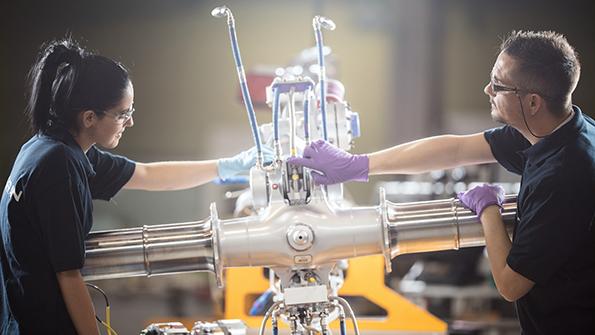
An Airbus A320 main landing gear is assembled at Safran’s factory in Bidos. Airbus is struggling to increase the A320neo’s monthly production rate.
As the French supply chain gradually makes its way out of financial fragility, notably through consolidation, the ongoing manufacturing ramp-up is keeping it under pressure. The COVID-19 crisis forced an unprecedented slowdown of the entire sector, and the recovery has been all the more challenging due to ever-growing demand and higher production targets.
Officials at French aerospace lobbying association GIFAS point out that the supply chain remains strained, and the stresses the industry has experienced should be acknowledged. But the sector has weathered an existential predicament, thanks in particular to its cohesiveness. OEMs helped small companies navigate dire straits in 2020-21. Although disagreements regularly occur between GIFAS members, the association’s efforts show that the sector is well structured.
- The capacity gap lingers due to growing demand
- Hiring is now the most serious concern
The tools created to save ailing suppliers are becoming permanent. Small companies are being monitored on a monthly basis to prevent bankruptcies. “Our supplier network is so integrated that the failure of one link may impact the entire chain,” Didier Kayat, president of GIFAS’ aerospace equipment group and Daher’s CEO, said at the association’s annual press conference on April 27.
In 2020, the French government and France’s Big Four—Airbus, Dassault, Safran and Thales—created the Ace Aero Partenaires fund to help small and midsize enterprises obtain necessary equity capital. Operated by asset management specialist Tikehau Capital, the fund was also aimed at spurring consolidation. It helped bring about 70 mergers, acquisitions and other consolidation moves, says GIFAS Chairman and Airbus CEO Guillaume Faury.
Separately, a holding company owned by Airbus, Safran and private equity firm Tikehau Capital has finalized the acquisition of Aubert & Duval from Eramet. Considered a strategic supplier of metal parts for Airbus, Safran and other aerospace and defense players, Aubert & Duval’s precarious financial situation had long been an industry concern. Eramet in 2020 announced its intention to divest itself of the company. The French government retains a golden (veto) share in Aubert & Duval.
Ace Aero Partenaires has added a new goal to its mission: supporting the production ramp-up. The aim is to avoid creating more bottlenecks. Kayat said that “2023 will be tricky, but we see the light at the end of the tunnel.”
Airbus is struggling to increase the A320neo’s monthly production rate to 50 this year and 65 by the end of 2024. The OEM delivered an average of 35 per month in the first quarter. Meanwhile, Safran delivered 366 Leap engines in the first quarter, an increase of 13% from the last quarter of 2022. Safran’s manufacturing operations have stepped up as planned, the company says. CEO Olivier Andries deemed the performance encouraging “in a context of persistent difficulties in the global supply chain.”
Production line delays due to missing components can be protracted. “Everybody is ramping up at the same time,” Faury says, referring to commercial, business and military aviation. “It is becoming harder to catch up.” The book-to-bill ratio for the French industry exceeded 1:1 last year.
Compared with precrisis demand, fleet renewal has become a stronger driver and fleet growth has decreased in importance, Faury notes. “In 2018-19, the supply chain was already finding it difficult to increase rates,” he recalls. The recruitment challenge was giving CEOs headaches then and has since worsened, impeding OEMs’ production ramp-ups. Recruitment recently surpassed energy prices as GIFAS members’ priority problem, he says.
The conundrum lies in finding the right teams and talent with specific skills at given locations, he says. One compounding factor is competition from other industries. Most recently, the French nuclear power industry expressed its own hiring challenges.
What about hiring more women? “The proportion of female recruits has grown to 27% from 25%,” says Clementine Gallet, president of GIFAS’ small businesses committee. “We see that as progress.” How to convince them to join aerospace? There is no one-size-fits-all solution, she says. “We should tell them they can find jobs other than in marketing and sales. . . . Educating them should start early, at the end of middle school or early in high school years.”
The CEO of a small GIFAS member company might have found a good approach to the issue at the university level. “You can find many young women studying mathematics,” Gallet explains. “That CEO needed employees for his automated machining tools. That is a job for mathematicians. He promoted the positions to female students and was successful, filling the vacancies with five of them.”
“We have role models we did not have 10 years ago,” Faury adds. These include Airbus Chief Technical Officer Sabine Klauke and Sandra Bour Schaeffer, CEO of Airbus UpNext, the OEM’s technology innovation arm.
